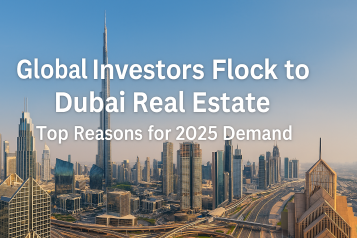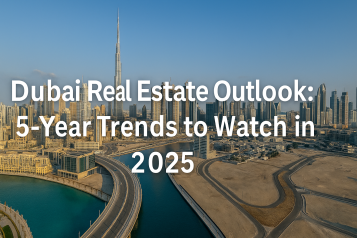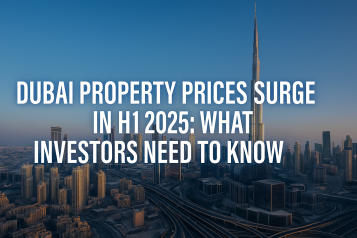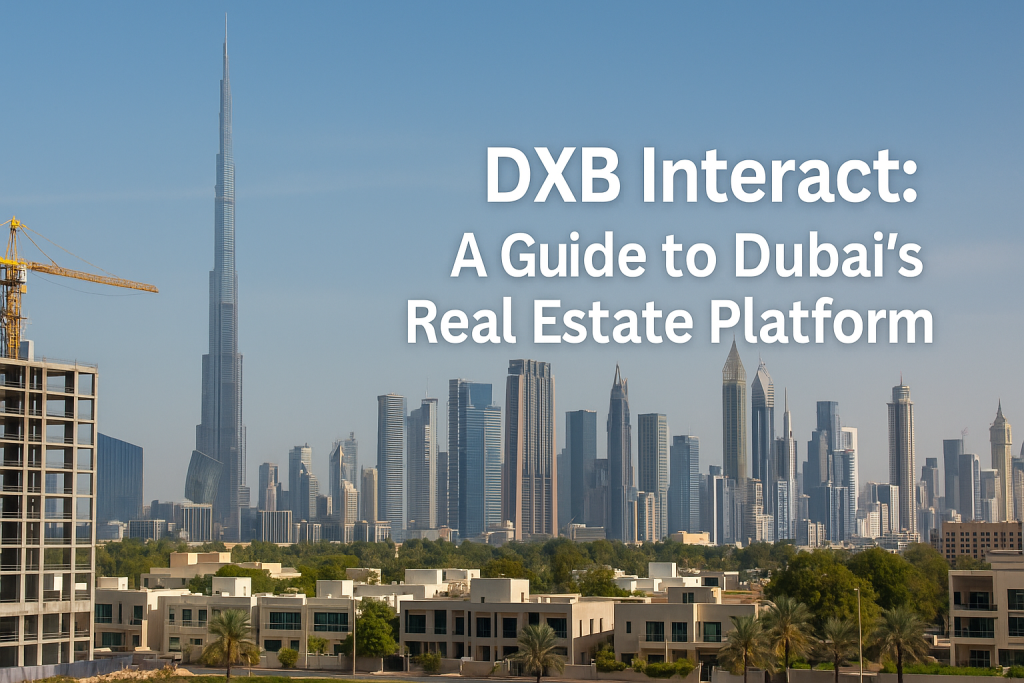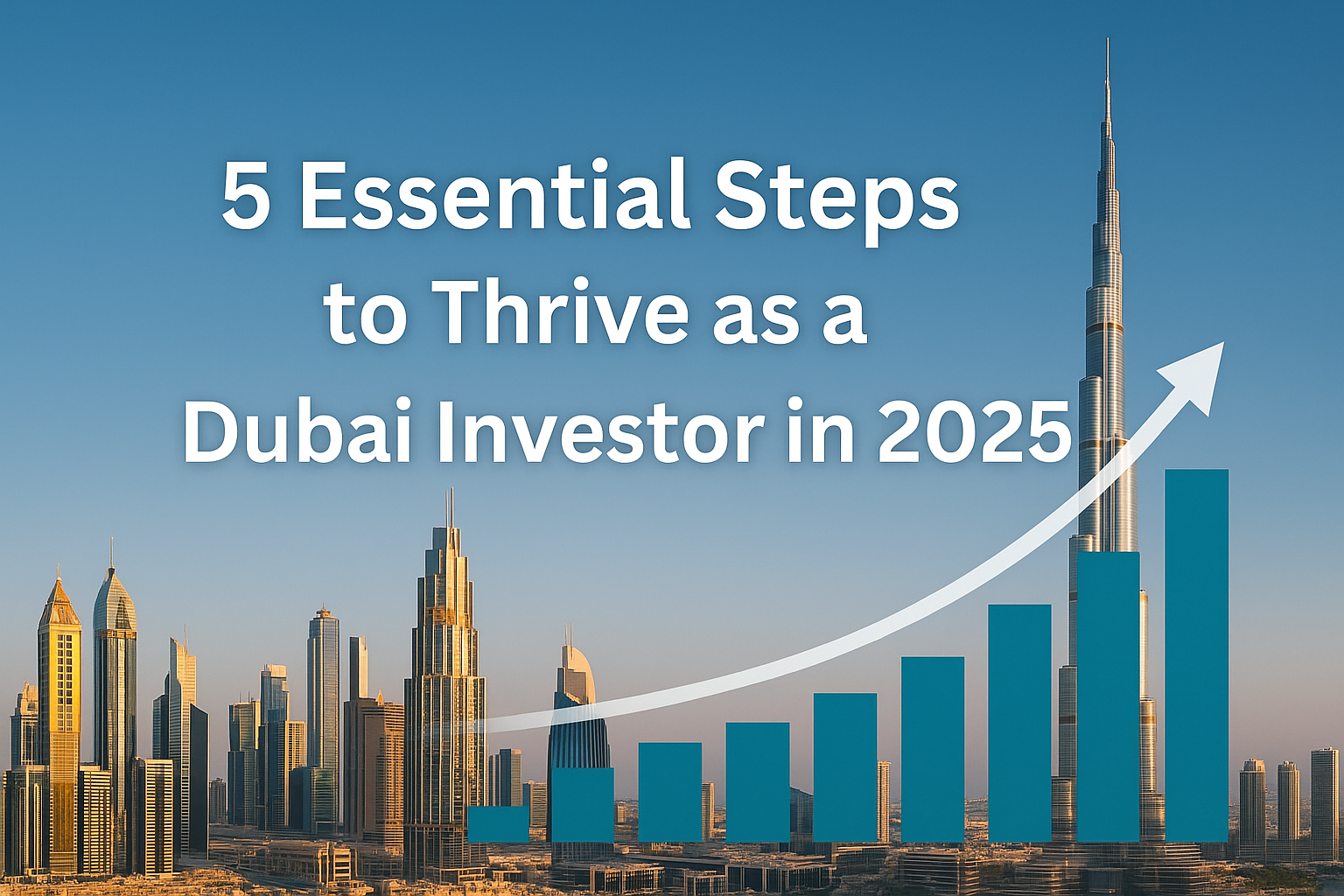

Table of Contents
- Introduction
- Why Dubai Still Pulls Global Capital in 2025
- Step 1: Do Strategic, Localized Market Research
- Understanding Demand Drivers
- Using Data to Identify Hotspots
- Analyzing Rental Yields and Price Trends
- Tools and Resources for Investors
- Step 2: Pick Asset Classes with a Clear Thesis
- Residential Apartments
- Luxury Villas and Townhouses
- Commercial and Industrial Spaces
- Off-Plan Properties
- Tokenized Real Estate Options
- Step 3: Use Fractional Ownership (Tokenized Real Estate) Intelligently
- What Fractional Ownership Means
- Benefits of Tokenized Investments
- Governance and Regulatory Safeguards
- When to Use Fractional Ownership vs. Full Titles
- Step 4: Diversify Across Sectors, Strategies, and Time Horizons
- Diversification by Sector
- Diversification by Strategy
- Diversification by Time Horizon
- Geographic Diversification in GCC Markets
- Step 5: Stay Compliant and Manage Risk Like a Pro
- Regulatory Compliance in Dubai
- Managing Financial Risks
- Operational Risk Monitoring
- Stress-Testing Your Investment Model
- Risks and Challenges Investors Must Watch in 2025
- Fees, Taxes, and Ongoing Costs (What to Budget)
- Case Study: A 2025 Portfolio Built for Growth and Resilience
- Mistakes to Avoid as a Dubai Investor
- Practical Checklist: First 30 Days as an Investor
- FAQs
- Conclusion: Your 2025 Dubai Edge
- Start Investing Smarter Today
Introduction
Dubai has emerged as one of the world’s most dynamic investment destinations. With Dubai property price surges in H1, 2025, the emirate offers unparalleled opportunities across real estate, fractional ownership platforms, and tokenized property markets. However, becoming a successful investor in Dubai takes more than buying property — it requires strategic insights, data-driven decisions, and compliance readiness.
Dubai was once a small fishing village with no oil and a bleak future.
Today, it’s a $110B economy, a playground for billionaires, and a global hub heads and shoulders above Europe and America.
Here’s how Dubai pulled off the greatest pivot of the 20th century: 🧵 pic.twitter.com/cNOfHrEVpe
— Genius Business 🇺🇸 (@GeniusBusiness_) September 1, 2025
This comprehensive guide breaks down the five essential steps to help you navigate Dubai’s fast-evolving market and achieve sustainable, high-yield returns.
Why Dubai Still Pulls Global Capital in 2025
Population Growth and Housing Demand
Dubai’s population is expected to surpass 4 million in 2025, with forecasts showing steady growth to 5.8 million by 2040 (Dubai Statistics Center). This rising population directly fuels housing demand, rental stability, and property value appreciation.
Attractive Rental Yields
According to Knight Frank’s Destination Dubai 2025 Report, rental yields average 5% to 7% for apartments and 4.5% to 6% for villas (Knight Frank Report) — outperforming major global investment hubs like London and Singapore.
Luxury Market Boom
High-net-worth individuals continue to drive Dubai’s luxury property surge. Prime villa prices have increased 94% since 2020, cementing Dubai’s position as one of the world’s hottest ultra-prime markets.
Tokenization and Innovation
Dubai Land Department (DLD) and the Virtual Assets Regulatory Authority (VARA) are establishing frameworks for property tokenization, making fractional ownership a regulated, mainstream investment model.
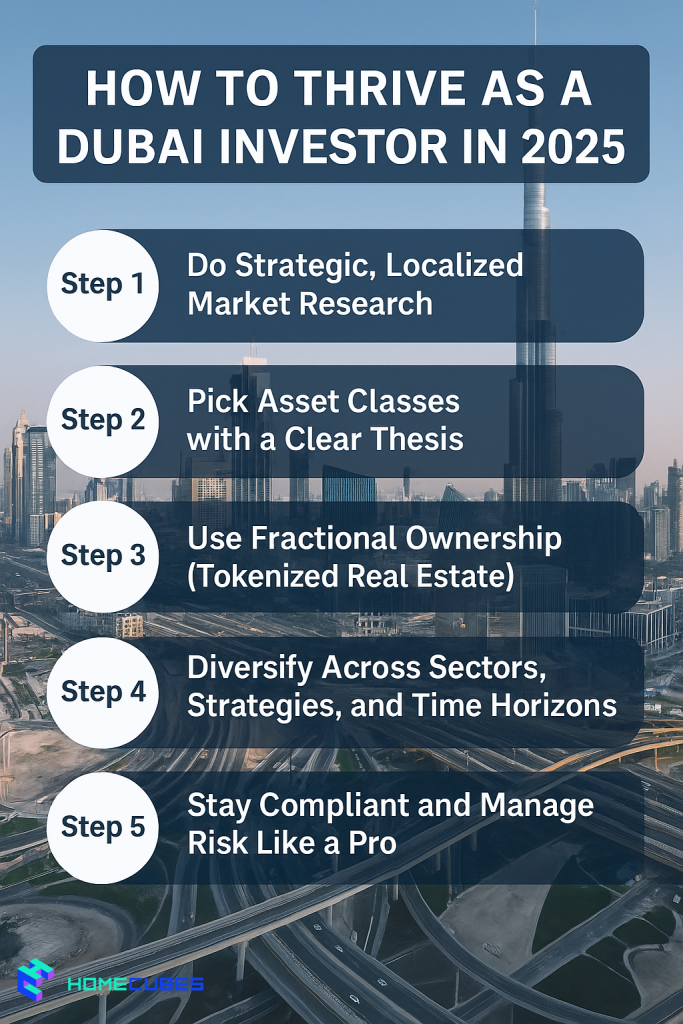
Step 1: Do Strategic, Localized Market Research
Becoming a successful investor in Dubai starts with in-depth research.
Understanding Demand Drivers
- Population inflows: Expats make up over 80% of Dubai’s residents, sustaining rental demand.
- Tourism: 2024 saw record-breaking 17 million international visitors, boosting hospitality-linked real estate.
- Infrastructure projects: Metro expansions and Dubai 2040 Urban Master Plan are shaping future growth corridors.
Using Data to Identify Hotspots
- Emerging Markets: Dubai South, Jumeirah Village Circle, and Dubai Creek Harbour offer affordable entry points with double-digit growth potential.
- Prime Locations: Palm Jumeirah, Downtown Dubai, and Emirates Hills remain high-demand zones for premium buyers.
- Rental Hubs: Business Bay, Dubai Marina, and DIFC dominate the rental income landscape.
Analyzing Rental Yields and Price Trends
Examine sub-market performance by tracking:
- Average rental yields per district
- Price per square foot trends
- Vacancy rates and absorption speed
- Historical performance versus planned infrastructure rollouts
Tools and Resources for Investors
- Dubai Land Department (DLD) Reports
- Knight Frank Destination Dubai
- Property analytics portals like Bayut, Property Finder, and DXBInteract
Step 2: Pick Asset Classes with a Clear Thesis
Dubai’s real estate market offers diverse opportunities. The key is to align your risk profile and goals with the right asset class.
Residential Apartments
- Pros: High rental demand, faster resale cycles, lower entry costs.
- Cons: Service charges can eat into returns — always analyze NOI, not gross yields.
Luxury Villas and Townhouses
- Pros: Excellent capital appreciation potential, especially in prime districts.
- Cons: Lower net yields; ideal for longer-term strategies.
Commercial and Industrial Spaces
- Business hubs like DIFC and Business Bay deliver 7%+ yields for Grade-A offices.
- Logistics parks and industrial spaces benefit from e-commerce growth and strong trade flows.
Off-Plan Properties
- Attractive payment structures with post-handover plans dominate 2025.
- Always prioritize RERA-approved developers and escrow-protected projects.
Tokenized Real Estate Options
Platforms like Homecubes enable investors to buy fractions of high-value properties, opening up institutional-grade assets to individual investors.
Step 3: Use Fractional Ownership (Tokenized Real Estate) Intelligently
Fractional ownership is reshaping Dubai’s investment model.
What Fractional Ownership Means
Instead of owning an entire property, you buy fractional tokens representing partial ownership. These tokens are backed by real assets and smart contracts.
Benefits of Tokenized Investments
- Lower Entry Thresholds: Start with as little as USD 1,000.
- Diversification Power: Spread investments across multiple premium assets.
- Liquidity Options: Trade tokens on regulated secondary marketplaces.
Governance and Regulatory Safeguards
Choose platforms aligning with DLD and VARA regulations to ensure:
- Secure title registration
- Transparent income distribution
- Investor-friendly governance frameworks
When to Use Fractional Ownership vs. Full Titles
- Use fractional ownership to gain exposure to premium properties to invest in Dubai real estate with limited funds in 2025.
- Use full titles when seeking financing leverage or long-term legacy investments.
Step 4: Diversify Across Sectors, Strategies, and Time Horizons
Diversification is a core strategy for any successful investor in Dubai.
Sector-Based Diversification
- Residential: Steady yields, strong demand.
- Commercial: Long-term corporate leases.
- Industrial: Rapid growth due to logistics demand.
Diversification by Strategy
- Yield-Oriented: Focus on rental income-generating apartments.
- Growth-Oriented: Invest in prime villas or emerging off-plan markets.
- Hybrid: Blend high-yield units with high-growth appreciation assets.
Diversification by Time Horizon
- Short-Term: Target rental yield optimization.
- Mid-Term: Capitalize on price surges in developing corridors.
- Long-Term: Align with Dubai 2040 Urban Master Plan milestones.
Geographic Diversification in GCC Markets
Dubai serves as a springboard into neighboring markets like Saudi Arabia, Oman, and Bahrain, amplifying regional exposure.
Step 5: Stay Compliant and Manage Risk Like a Pro
Regulatory Compliance in Dubai
- VARA Licensing: Mandatory for tokenized property platforms.
- DLD Integration: Seamless approval required for title deed tokenization.
- AML/KYC Frameworks: Protects both investors and institutions.
Managing Financial Risks
- Stress-test financing at EIBOR + 300 bps scenarios.
- Maintain 6–12 months of expense reserves.
- Avoid over-leveraging; target DSCR ≥ 1.3x.
Operational Risk Monitoring
- Check developer reputation and delivery history.
- Verify property management SLAs and historical service charge records.
Risks and Challenges Investors Must Watch in 2025
- Regulatory Shifts: Tokenization laws are evolving.
- Supply Pressures: Oversupply in mid-market segments may impact yields.
- Potential Market Corrections: Fitch warns of possible double-digit price declines if supply outpaces demand (Reuters Analysis).
Fees, Taxes, and Ongoing Costs (What to Budget)
| Cost Component | Rate | Notes |
| DLD Registration Fee | 4% | Paid on property transfer |
| Oqood Fees | AED 3,000 | Off-plan projects only |
| Mortgage Registration | 0.25% of loan value | Capped at AED 1,000 |
| Homecubes Fees | Transparent, nominal | Disclosed upfront |
Case Study: A 2025 Portfolio Built for Growth and Resilience
Investor Capital: USD 150,000
Portfolio Allocation:
- Luxury Apartment: Palm Jumeirah
- High-Yield Unit: JVC
- Fractional Stake: Logistics warehouse via Homecubes
Results:
By 2025, this portfolio achieved an 18% ROI due to balanced exposure across sectors and liquidity from fractional ownership.
Mistakes to Avoid as a Dubai Investor
- Relying on headline yields without analyzing service charges
- Over-concentration in one developer or district
- Ignoring governance and exit clauses in fractional investments
- Skipping due diligence on escrow protections for off-plan projects
Practical Checklist: First 30 Days as an Investor
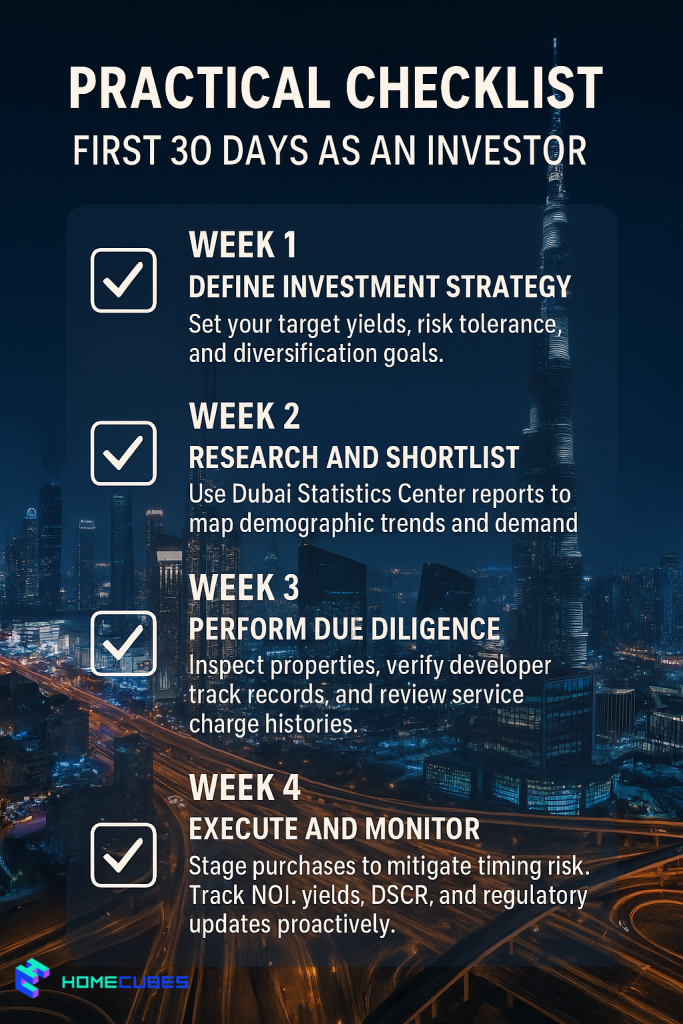
Week 1: Define Investment Strategy
Set your target yields, risk tolerance, and diversification goals.
Week 2: Research and Shortlist
Use Dubai Statistics Center reports to map demographic trends and demand
Week 3: Perform Due Diligence
Inspect properties, verify developer track records, and review service charge histories.
Week 4: Execute and Monitor
- Stage purchases to mitigate timing risk.
- Track NOI, yields, DSCR, and regulatory updates proactively.
FAQs
Is Dubai still a good investment market in 2025?
Yes, Dubai offers strong yields, population-driven demand, and sustainable growth.
How much capital do I need to start investing?
With fractional ownership platforms, start from USD 1,000.
Is fractional ownership regulated?
Yes, under DLD and VARA frameworks, tokenized real estate is officially recognized.
Conclusion: Your 2025 Dubai Edge
Succeeding as a successful investor in Dubai in 2025 means thinking bigger but acting smarter. With the right mix of:
- Localized market research
- Targeted asset allocation
- Fractional ownership strategies
- Rigorous compliance and risk management
…you can build a future-proof portfolio and capitalize on one of the world’s fastest-growing investment hubs.
Start Investing Smarter Today
Homecubes is pioneering fractional property ownership to make Dubai’s premium real estate accessible, secure, and compliant. We’ve applied for our VARA license, and services will launch upon regulatory approval.
Join early to unlock opportunities designed for forward-thinking investors.

